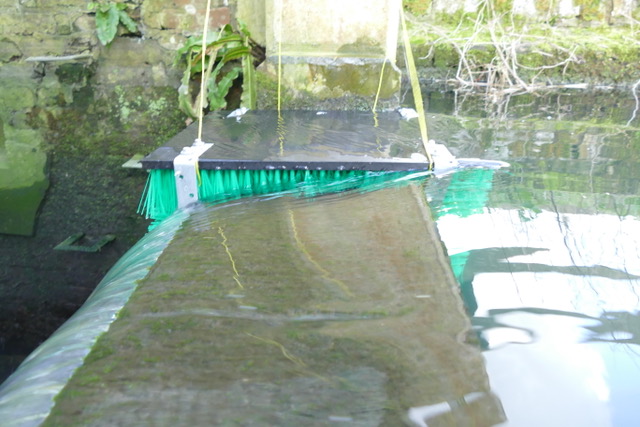Last May, Faversham Life wrote about the perilous plight of elvers arriving at the Creek from the Sargasso Sea. Matthew Hatchwell updates us on the actions taken in Faversham to protect this critically endangered species
Words Matthew Hatchwell Photographs Matthew Hatchwell

- A bristle board is life or death to elvers
Some good news at this otherwise grim time for all of us: the bristle boards on the two sluices at the outfall from the Westbrook and Stonebridge Pond into Faversham Creek are now in place — just in time for the 2020 elver run!
Following extensive discussion on the design of the boards, we settled on outward-facing, double-density HDPE bristle boards on both the up- and downstream faces of the two sluices, linked by an inverted board to help elvers through the strong current across the tops of the sluices. They’re designed to be removable for cleaning, and during winter months when they’re not needed. We received (after long waits) quotes from two private contractors to provide the boards commercially, but both came in at £6-7,000, so after extensive discussions with Dave Powell of the Environment Agency we decided instead to use bristle boards that the EA already had in stock and that we cut to size and assembled ourselves using steel brackets, bolts and self-tapping screws. Many thanks to Dave and the EA for that. We installed the boards ten days ago in coordination with Sally Kerin and Bob Gomes from the allotments association.
The boards are currently held in place by their own weight. We were concerned that that might not be sufficient on very high tides when the force of incoming water might lift the boards out of place, but Bob monitored them over the course of the unusually high tides on 12-13 March and that doesn’t appear to have been a major problem. We’re not overly concerned about vandalism because they’re within the confines of the allotments and fairly difficult to get at. We will continue to monitor them, however, and fix them in place more securely if necessary. Covid-19 permitting, we’re planning to watch the sluices and bristle boards over the spring tides on the nights of 10 and 11 April to get an idea whether elvers are getting through more easily than when we observed them at the same site last year.
As many of you know, the Medway and Swale Estuary Partnership (MSEP) at a meeting in December approved a concept a) to assess the permeability for eels and elvers of outfalls from freshwater courses into the Medway and Thames estuaries along the entire northern slopes of the boroughs of Medway and Swale, b) to develop a comparative monitoring protocol probably using the so-called mophead methodology, and c) to design a public engagement campaign to increase awareness of eels as part of the history, culture and ecology of north Kent. Our next step is to write up a full, detailed proposal for potential donors.
Given the overall plight of European eels, these are both small steps in terms of what needs to be done across their broader range here in the UK and beyond. British Wildlife magazine asked me last year to write them an article which I’ll complete shortly, documenting what we’re doing for eel conservation here in north Kent in the hope that our experience will be instructive for communities in other parts of the country. For anyone who’s not already a subscriber, I’ll send you a link to that once it’s published.
All best and many thanks to everyone on this circulation list who has helped in one way or another over the past 12 months — and in particular for the offers of financial support for the eel passes at the allotments which, in the end, we didn’t need to take anyone up on!
Matthew Hatchwell
